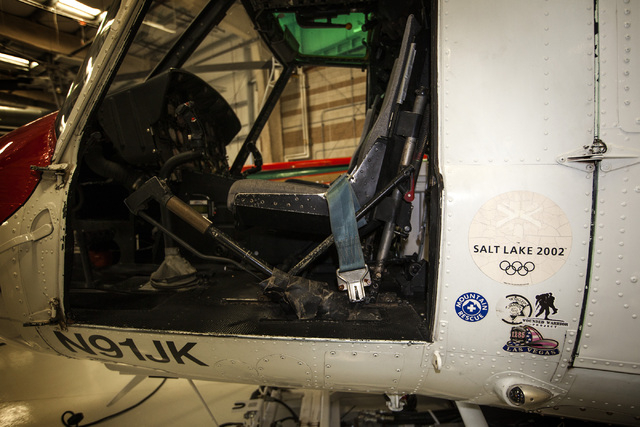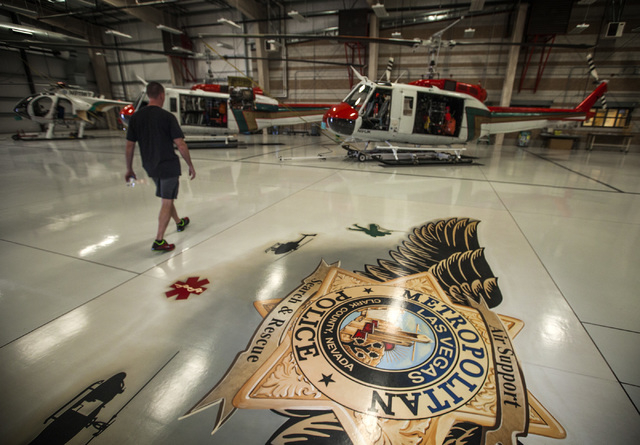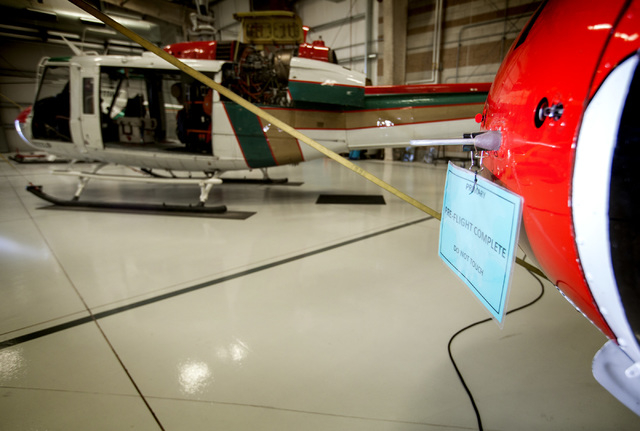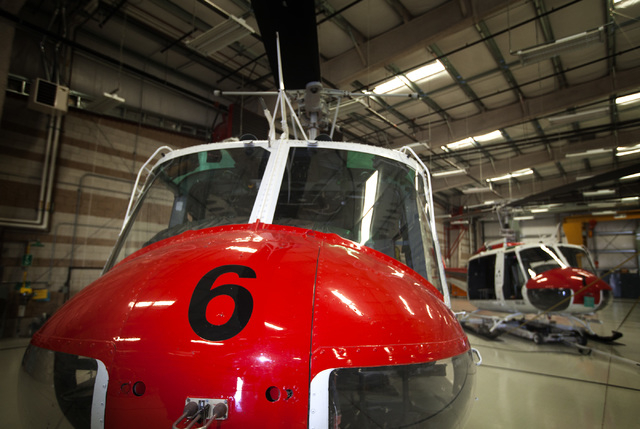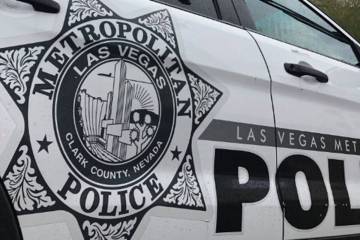Metro used federal program to get military helicopters, equipment
Ruvan Navarro is thankful to be alive.
The 17-year-old Las Vegan and two friends, Ricky Azarro and Jonny La, both 18, were out for an early morning climb along White Rock Trail at Red Rock National Conservation Area on Aug. 22 when something went wrong. About 150 feet up, Navarro grabbed a loose boulder that slipped and pinned his arm to the cliff. Navarro dislodged the rock to reveal a gaping hole in his right bicep.
He was bleeding profusely and struggling to stay conscious. His friend La helped wrap his arm with gauze from a first-aid kit they had brought along, and they called 911.
When Las Vegas police arrived to rescue them, it was via helicopter.
Metro obtained that helicopter through a controversial military surplus program. Known as “1033” for the section number of the federal law that defines it, the program since 1990 has supplied sheriff’s departments large and small with everything from from desks and file cabinets to assault rifles and armored vehicles — for the cost of shipping.
While some look at it as cost-saving — taxpayers already have paid for the equipment, so police are keeping it in use without having to buy something new — it has come under criticism as law enforcement has continued to militarize. The most recent flash point has been in Ferguson, Mo., where a white police officer fatally shot Michael Brown, an unarmed 18-year-old black man.
The killing touched off violent confrontations between protesters and police. A major criticism has centered around the military equipment and weapons officers used, including armored cars, assault and sniper rifles, and personal armor.
Some have called for the program to be tempered.
But the equipment itself is not the problem, according to Chuck Callaway, Metro’s director of intergovernmental services. Instead, it’s the way some departments have deployed it.
“I think it would be a knee-jerk reaction to stop the program,” Callaway said. “It’s how you use the equipment that counts.”
The helicopter used to hoist Navarro’s trio to safety was a Vietnam War-era Bell UH-1 Iroquois, commonly called a Huey. Metro got it in 1998. The department also got a twin Huey and a Zodiac rescue boat the same year.
After some initial engine upgrades, the helicopters have helped anchor Metro’s Search &Rescue fleet for their diciest, higher-altitude rescues.
The squad has to be versatile, and their equipment has to match, Search &Rescue Lt. Jack Clements said.
“We may have to do a rescue in Laughlin on the Colorado River, which is at 500 feet, or at Mount Charleston, which is 12,000 feet,” Clements said.
Congressman Hank Johnson, D-Ga., is among those pushing to scale back the 1033 program. Johnson plans to introduce a bill that would limit the program and prohibit the acquisition of automatic weapons, armored vehicles, grenade launchers and aircraft.
If a law enforcement agency decides it needs a piece of equipment, Johnson said, his proposal would make local governments, such as county commissions or city councils, vote on whether to buy it commercially.
“Citizens want a police department to protect them and to serve them,” Johnson said.
If Johnson’s bill becomes law, Metro wouldn’t be able to get helicopters as cheaply as it did before.
Civilian law enforcement agencies, Johnson added, equipped with military-grade equipment and weapons “creates a recipe for havoc, and we saw that unfold in Ferguson. We simply have to put the brakes on the program.”
Sen. Claire McCaskill, D-Mo., is planning to lead a hearing on police militarization Sept. 9. McCaskill, who chairs a Senate subcommittee on financial and contracting oversight, is expected to hear from the federal officials who oversee the 1033 program and from law enforcement agencies who have used the program to obtain weapons and equipment, according to her office.
Metro’s Callaway takes a finance-focused view.
“If we had to purchase that through our funds, that’d be a huge hit on the taxpayers,” Callaway said. New helicopters that can do what Metro’s two Hueys do now would cost $18 million, he said.
Replacement parts for the helicopters — such as rotors, blades and engine parts — are also obtained through the surplus program. A single blade for the helicopter can cost up to $90,000.
Had Metro purchased a newer, commercially available helicopter, any repair or upgrade would have to come from county money.
Metro has used the 1033 program to obtain other types of equipment including two remote-operated robots, about 300 tourniquets, and a few large storage containers.
Metro has not used the program to obtain any weapons, body armor, armored transport vehicles or mine-resistant vehicles, according to Clements.
“I know for us, it’s equipment that can save lives,” he said.
But other Nevada law enforcement agencies used 1033 to get deadlier tools.
Of the six armored and mine-resistant vehicles in Nevada obtained through the surplus program, none resides in Clark County. Instead, they are mostly in rural areas, such as Humboldt, Elko and Nye counties, according to a New York Times map showing the distribution of military equipment across the country. Law enforcement agencies in Douglas County — home to about 46,000, or 3 percent of the population of Las Vegas — received two grenade launchers, 30 assault rifles and 20 pieces of body armor.
Washoe County, the only other urban county in Nevada, received 120 assault rifles. The Reno Police Department has its own mine-resistant truck.
Nationally, critics have questioned why less populated rural areas need that type of equipment.
Clements is aware of the mounting criticism surrounding the use of military equipment by civilian law enforcement but said that certain equipment, like the helicopters, are vital.
“We’re not the military, but we do need certain tools,” he said. “There may be a legitimate use for that type of equipment if you have a hostage or barricade situation.”
For Metro, those tools are used primarily in saving people like Navarro and his friends.
To Navarro, the sound of Metro’s approaching Huey was “a great feeling,” as he clung to the side of the mountain.
“It was a sign of hope,” he said. “Without them we probably would have never made it.”
Contact reporter Colton Lochhead at clochhead@reviewjournal.com or 702-383-4638. Find him on Twitter: @ColtonLochhead.



